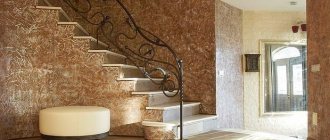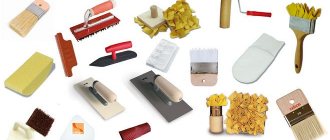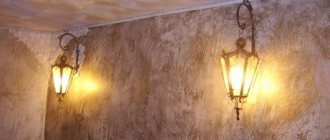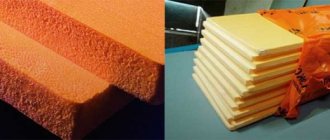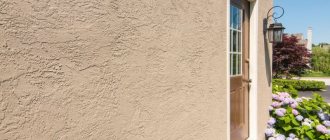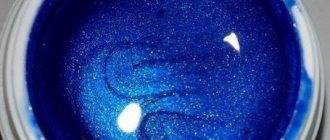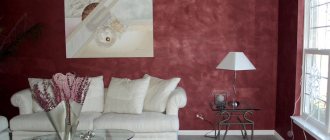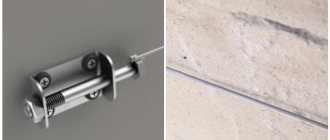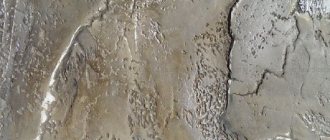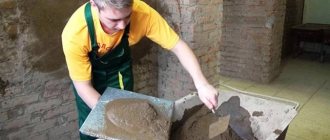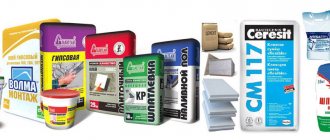High-strength, with characteristic structural grooves (“bark beetle»
).
Tinted.
Color:
Quartz plaster is produced in white color, but Structural putz can be repainted within 6 hours after application - to do this, use water-dispersed paints of the selected color.
Properties:
- convenient and practical;
- application does not leave marks on the hands of the master, and in subsequent use it shows itself only from its best side:
- the layers remain breathable, durable and resistant to direct sun and pressure changes.
- After application you get a grainy surface and shallow grooves.
- It has very wide structural capabilities!
Suitable bases:
Concrete and plastered surfaces, plasterboard sheets, slabs (chipboard, fiberboard, fiberboard), etc.
Drying time (at 23°C and 65% relative humidity):
Specifications:
Vapor permeability µ-level 40
0.04 kg/(m2*h) (EN 1062-3)
Compressive strength (28 days)
Bending tensile strength (28 days)
E-module in dynamics (28 days)
Application system
Surface preparation:
Strukturputz quartz plaster is very plastic, so it can be used to create the most unexpected effects of the selected surface, be it walls or ceilings of a room. Before applying the plaster, it is necessary to clean it from dirt and seal cracks, additionally treat it with deep primer (Diepgrond OV or Diepgrond) and preliminary primer SPS-Forkwarts (Voorkwarts).
Application:
If the Structureputz quartz plaster seems too thick when stirring, add water (however, its amount should not exceed 3% of the total volume).
After treating the surfaces, apply Strukturputz plaster with a trowel - stainless steel if this is the first application and plastic if you are smoothing the layer or creating one or another decorative effect (wooden bark, chaotic structure).
Storage:
Store in a dry and cool place. Protect from frost! The container must be tightly closed after use.
General
Safety. Keep away from children. Do not allow to enter the sewer.
Source
Decorative plaster
Decorative plaster is a solution intended for interior decoration of walls in residential and public buildings. Plaster acts as a finishing coating, with which the surface is decorated and gives it an aesthetic appearance. Plaster appeared during the Renaissance, when various frescoes were depicted on the walls. Every person can remember the ancient way of decorating surfaces from history books. Today there are a huge number of varieties of plaster. Each type of solution is unique in its individual properties, which allows you to create an unusual and sophisticated interior. Modern plaster acts as an independent coating, giving repair work new possibilities.
San Marco (San Marco)
If you are looking for thin-layer decorative plaster from the premium segment, then it should be products under the San Marco TM.
The company's mixtures are sold all over the world. These are Italian-made materials whose history begins in 1937. At the time of writing the review, the range included 30 types of decorative materials to create 50 textures. Add in over 1,500 color options and the finishing options are endless. The company's catalog presents decorative mixtures, bases and protective agents for decorative coatings. Preference is given to highly artistic thin-layer materials for interior and exterior decoration. We recommend visiting the official website using the link below! Characteristics of San Marco decorative plasters
| Characteristics | STUCCO VENEZIANO | MARMORINO CLASSICO | CONCRET_ART |
| Application area | For application to prepared mineral, plasterboard and wooden substrates indoors. The finishing layer does not require wax protection. The base is white, tinted using the Marcromie system. Apply two base coats and one finishing coat. Suitable for use in rooms with high humidity. | A mixture based on mineral binders for the exterior and interior finishing of prepared plastered or painted substrates that do not crumble but absorb water. Fraction size – up to 0.7 mm. The number of layers applied is at least 2. Can be tinted according to the catalogue, the base color is white. | To create a decorative layer with the strength characteristics characteristic of cement. Suitable for all types of prepared substrates. Used for interior and exterior work. Number of layers – 1-2. The finished coating is resistant to frequent wet cleaning, as well as atmospheric influences. |
| Decorative effect | Imitation marble. | Imitation marble, velvety marble, “pepper and salt”, brush marks. | Aged concrete, formwork, washed surface, fine or medium sanding, plaster effect, fine-mesh surface. |
| Delivery option | Ready mixture. | ||
| Packing | Bucket 1, 5, 25 kg. | Bucket 1.25 kg. | |
| Compound | Water, modified acrylic copolymer, filler. | Water, air lime, mineral filler, modifying additives. | Water, acrylic copolymer with siloxane modification, filler, additives. |
| Consumption, kg/m² | 1,4-2 | 2,5-3 | 0,8-1,3 |
| Price, rub./kg. | 753 | 449 | 543 |
| Cost of 1 m² of coverage, rub. | 1054-1506 | 1123-1347 | 434-706 |
Impressions from use. A large selection and decent quality at a high price - this is how you can briefly describe the impressions of using plasters from this manufacturer. Cost is the only negative component. You also need to take into account that in order to obtain a decorative effect, you will have to strictly adhere to the manufacturer’s recommendations and use auxiliary materials from San Marco, which affects the overall cost of finishing. However, you can save on the services of specialists - there are a large number of master classes in the form of video lessons on the Internet.
Video about STUCCO VENEZIANO and its application:
VARIETIES OF DECORATIVE PLASTER BY BINDING SUBSTANCE
The most common solution is acrylic plaster
. The binder is a high molecular weight polymer, presented in the form of acrylic resin. Thanks to the main component, the solution is easy to apply and has good elasticity. Acrylic coating is available to consumers in the form of a ready-mix. A wide range of colors allows you to create your own interior, distinguished by beauty and sophistication. However, the acrylic mixture is confirmed to crack after a long period of use. Decorative plaster of this type has the lowest vapor permeability and is not able to withstand exposure to ultraviolet rays.
THERE ARE OTHER TYPES OF DECORATIVE PLASTER, DIFFERING IN THE BINDING SUBSTANCE:
- mineral.
The main component here is cement. Mineral plaster is available in the market in dry powder form. Therefore, before use, it must be diluted with water in the ratio recommended by the manufacturer. The mineral mixture has a good level of strength, resistance to mechanical and other influences; - silicone.
The binder is a synthetic resin. The component is able to give the solution excellent plasticity and moisture resistance. Silicone plaster is easy to apply to the surface. Due to its unique properties, it is recommended for use in bathrooms; - silicate.
The main feature of the silicate substance is its component in the form of liquid glass. It includes quartz sand, alkaline and potassium carbonate, potassium hydroxide. This makes it possible to impart reliability and strength to the plaster, as well as activate astringent, adhesive and impregnating properties. Rotting of walls, formation of mold and mildew is excluded. Excellent resistance to moisture.
You need to choose decorative plaster taking into account the characteristics of the room being treated. If there is a high level of humidity in the room, then it is better to purchase plaster that can form a water-repellent layer on the wall.
average cost
Pebble plaster will cost more than that created on the basis of cement. The cost of one package of 25 kilograms will vary depending on the specific brand. Other factors also affect the cost of finishing materials:
- place of sale;
- category, grade;
- type of mixture;
- mixture composition;
- region of production.
For example, a bag of Ceresit mixture sells for an average price of 550-850 rubles, Teplon - 450-500 rubles, and Krysel costs an average of 400 rubles. But the price range can be quite serious. At Vetonit, the price varies from 600 to 2500 rubles.
If you follow all the rules for applying mineral plaster to the surface, safety precautions and purchase high-quality finishing materials, the resulting finish will last a long time without losing its aesthetics and without cracking.
VARIETIES OF PLASTER BY TYPE OF FILLER
Structural.
Structural plaster is an acrylic and silicate-based material with a thin-layer structure. To be able to create a structural coating, manufacturers add marble chips or quartz to the mixture. If we consider the resulting appearance, it transforms into a granular, heterogeneous mass. The mixture is divided into three subtypes:
- fine-grained. After drying, it looks almost flat, but gives the wall the effect of fine crumbs;
- medium grain. After application they can create a noticeable relief on the walls;
- coarse-grained. After application they can create relief on the walls.
Regardless of the subtypes, structural decorative plaster creates a layer that has high air tightness, excellent resistance to adverse weather conditions and high humidity. The mixture can be applied with a roller, sprayer, or spatula with a total consumption of 3 kg per 1 sq.m. It is not recommended to add additional coloring agents to the finished structure.
Textured.
This type of decorative plaster has a coarse, highly viscous structure, to which small pebbles, fibers, wood, mica, and mineral chips are additionally added. The mixture is suitable for use on brick, wood, concrete, plastered surfaces. Thanks to special particles, the plaster effectively masks wall defects. There is no need to pre-treat the surface, the main thing is to clean and dry it in advance. It is also recommended to apply an adhesive compound to the wall.
DIY application instructions
Instructions on how to apply the material to obtain the desired pattern and achieve a long-lasting effect:
- Remains of construction debris, dirt, and dust are removed from the surface. This can be done with a vacuum cleaner, or if it is heavily soiled, with a damp cloth.
- Examine the surface for cracks, flaws, chips, depressions, and fallen parts. If there is, then apply a primary leveling layer of gypsum plaster.
- Base of the wall. For brick, concrete, wood, mortar will be needed in different quantities. Using a good primer will help (it’s worth priming in 2 or even 3 layers).
- Wait for the preliminary leveling layer to dry completely. Lay out a protective layer of plaster already on an acrylic base.
- Then the surface is treated with a deep penetration primer. This procedure can be done several times after each drying of the previous layer.
- Apply the composition to the prepared surface. This work is performed with a roller covered with fur or fabric. It should be medium sized and new, unused.
- Allow the first layer to dry, and then use a foam roller to give the coating the desired texture.
- Formation of the drawing. The spatula is used to make movements on which the final texture of the surface depends. Using slight pressure with a spatula, make indentations of such a degree that a beautiful stencil pattern is obtained.
- Treat the completely dry surface with a finishing coat (toner, wax or paste).
OTHER SPECIFIC TYPES OF PLASTER
There is colored decorative plaster, which is made from acrylic and marble chips. This type of solution is available on the market in fifteen shades. Before use, the surface should be thoroughly prepared and dried, and the plaster should be applied in one layer.
LET'S CONSIDER OTHER TYPES:
- rollerball It is a material that includes natural fillers of various fractions. After application, it is recommended to additionally treat the surface with a trowel using various movements to obtain the desired relief;
- latex plastic. It is a unique mixture that can imitate natural glossy stone. To achieve naturalness, colors are mixed in small quantities;
- "wet silk" Effectively imitates fabric with pearlescent shimmer. After complete drying, the treated surface can be subjected to wet cleaning;
- "sea breeze". Presented in the form of a translucent coating, to which mother-of-pearl and fine-grained sand are added.
Thanks to the abundant assortment on the modern market, each consumer has an excellent opportunity to create a unique interior taking into account personal needs.
Silicone
The protective and decorative properties of the coating are especially important for the facade and basement of the house
This finishing material contains an additive in the form of silicone resin to improve the properties:
- Silicone plaster is already devoid of such a disadvantage as high adhesion of dirt to the wall.
- Colors last better due to increased UV resistance.
- Vapor permeability also increases. The remaining advantages remain the same as in the previous version.
For facade work, silicone plaster is the best choice in terms of quality. But the price is 20-30% more expensive than acrylic.
Examples: Ceresit CT 74, Perel Silicio Bark Beetle, ECOROOM SILKSTONE.
The video below shows a comparison of two types of façade polymer plaster.
WHAT ADVANTAGES DOES DECORATIVE PLASTER HAVE?
Today, plaster has gained unprecedented popularity in the field of finishing interior walls. You can carry out repairs yourself or with the assistance of specialists. Decorative plaster has many advantages:
- effectively masks unevenness and various wall defects;
- resistant to negative weather influences;
- some types do not require pre-treatment of walls;
- creates a moisture-resistant top layer;
- provides additional sound insulation;
- helps turn any interior ideas into reality;
- the surface acquires a huge number of positive properties.
Interior options
Ideas for interior design with this plaster finish:
- Terracotta effect of the fireplace area . The warmth of the fire is depicted over the entire height of the wall with tints in the texture of the finish.
- Bathroom decoration in a classic style . The calm, measured version of the interior looks chic and simple at the same time.
- Golden tone and forged stair elements . The sophistication and luxury of the texture is achieved due to the absence of bright and pretentious shades.
- Matte sand wall . Ideal in the living room, when decorating rooms in eco-style.
- Imitation of masonry from stone blocks . Country style will look great in a spacious hall or a spacious living room.
- The coating is characteristic and unambiguous - it is sand . The background in the interior here is created in pastel colors. Accessories and textiles, which are placed in the finishing area, play an important role.
We invite you to look at photos of interior options with decorative “sand” plaster.
Terracotta around the fireplace:
Decorative plaster “sand” in terracotta color in the interior:
Classic style bathroom:
Decorative plaster “matte sand wall in eco-style”:
Another interesting option for finishing with sand plaster:
WE FINISH THE WALLS WITH DECORATIVE PLASTER OURSELVES
Treating walls in a house using decorative plaster is an interesting and exciting process. You can make any idea and fantasy come true. Before starting finishing work, it is recommended to prepare the walls: remove dust from cement, clean the surface of flaking elements, and dry thoroughly. If you decide to use Venetian plaster, then an approximate algorithm of actions is as follows:
- performing plastering using a wide spatula. The strokes can be anything: wide, narrow, sweeping or with spaces. Afterwards it is recommended to dry the resulting layer;
- the next step is to cover the gaps of the previous layer. When finished, dry;
- grind using a smooth steel tool;
- To give a glossy effect, coat the walls with a special varnish.
If you decide to use textured plaster, then remove the old coating and dry the walls thoroughly. Then prime. It is necessary to proceed to the next step only after a day. Apply the plaster with a soft spatula and give the desired relief. You can use rollers or stencils to achieve chic and sophistication in your future interior.
Structural plaster is applied with a trowel, which can be made from stainless steel. After applying the solution, wait three minutes and smooth it out in a circular motion using a plastic trowel. Remove unnecessary excess plaster with a spatula. It is recommended to carry out work from corner to corner to avoid the occurrence of noticeable seams.
VGT (VGT)
The Russian company VGT has been producing paints and varnishes and plaster compositions for decorative finishing since 1992.
The latter are represented by the Gallery line, which includes 16 thin-layer and textured plasters, as well as decorative paints and tools for working with all of the above. By combining these materials, you can get both truly unique and standard textures: bark beetle, Venetian plaster, wet silk, pebble, etc. Characteristics of VGT decorative plasters
| Characteristics | Gallery “Wet silk” | Gallery "Venetian" | Gallery “Colored plaster” |
| Application area | Thin-layer decorative plaster for interior work. The required texture is created in 2 layers. Apply to concrete, brick, plastered surfaces and gypsum plasterboard structures. Available in 5 base colors, the white base is tinted by hand. The finish is suitable for rooms with high humidity, the coating is wash-resistant. | Fine plaster for creating multi-layer coatings. It is applied to an exceptionally flat base: stone or plastered, made of gypsum plasterboard and fiberboard. For interior work: finishing walls and other interior elements. The base composition can be tinted in bulk, using, among other things, highly concentrated colors. | Granular plaster based on marble chips and acrylic binder. For application on mineral surfaces, for interior and exterior use. Available in 7 colors. The finished surface is resistant to wet cleaning and has high hardness. |
| Decorative effect | Iridescent silk. | Imitation marble. | Colored marble chips (grain size 1-1.5 mm). |
| Delivery option | Ready mixture. | ||
| Packing | Bucket 1 or 6 kg. | Bucket 8 or 16 kg. | Bucket 18 or 50 kg. |
| Compound | Water, styrene-acrylic copolymer, modifying additives, filler, pearlescent pigment. | Water, polymer, filler, modifying additives. | Water, polymer, modifying additives, mineral filler. |
| Consumption, kg/m² | 0,15-0,3 | 0,25-0,4 | 5-6 |
| Price, rub./kg. | 640 | 124 | 98 |
| Cost of 1 m² of coverage, rub. | 96-192 | 31-50 | 490-588 |
Impressions from use. Some customers complained about peeling of applied coatings, not only outside, but also inside the building. When analyzing the situations, it turned out that in order to achieve the best effect when preparing the base, it is necessary to use a primer from the same manufacturer, without deviating one step from the manufacturer’s recommendations. VGT is in demand due to its comparatively low price; the product has established itself as a budget option. Most of the positive reviews are justified precisely by the price and wide range, which is very important in these difficult times.
Video about VGT “Wet Silk” and its application:
Optimist
Optimist Group of Companies is a Russian manufacturer of paints and decorative coatings since 1998. It owns 2 brands under which decorative plaster is produced: Optimist-Elite and Rauf Decor.
At the time of writing the review, the company’s assortment includes 40 options for mixtures that can be tinted. These are highly artistic thin-layer coatings for interior work, as well as universal mixtures for creating grooved and pebble textures. They are supplied ready-made and require exceptional quality of base preparation. Characteristics of decorative plasters Optimist
| Characteristics | Optimist-Elite “Marble Pattern” | Optimist-Elite “Moroccan plaster” | Rauf Decor GRANULUM (1.2 mm) |
| Application area | For interior work on prepared substrates of any type. The base is white, tinted according to the catalogue. A thin-layer coating is created by applying the mixture in 2 layers. Be sure to use wax to increase moisture resistance. | For application on any type of perfectly smooth substrate. Apply in 2 layers. It is tinted in bulk. For interior work only. To increase moisture resistance and durability, wax is applied to the coating. | For application on surfaces made of mineral material or primed gypsum boards. Apply in 1 layer. Available in two fractions: 1.2 mm and 2 mm. Suitable for external and internal work. 24 color compositions. The finished coating is resistant to moisture and abrasion. |
| Decorative effect | Raw marble. | Moroccan plaster. | Colored mosaic. |
| Delivery option | Ready mixture. | ||
| Packing | Bucket 7 or 15 kg. | Bucket 15 (grain size 1.2 mm) or 25 kg (grain size 2 mm). | |
| Compound | Water, acrylic latex, marble chips, mineral fillers, additives, thickener, modifying additives, pigment. | Water, acrylic latex, filler, additives, thickener, pigment. | Water, acrylic latex, marble chips, additives, thickener. |
| Consumption, kg/m² | 1-2 | 0,35-1 | 2-2,5 |
| Price, rub./kg. | 252 | 238 | 97 |
| Cost of 1 m² of coverage, rub. | 252-504 | 83-238 | 194-243 |
Impressions from use. The products successfully compete with imported analogues in price, without compromising quality. Supplied in convenient packaging, it is easy to select the right quantity based on average consumption, without overpaying for excess material. You also need to take into account that applying highly artistic coatings yourself requires skills, and the cost of hired workers will be more expensive than the mixtures used. The company often conducts master classes where you can learn a lot; there are many videos on the Internet with different application techniques.
Video about Optimist-Elite “Marble Pattern” and its application:
